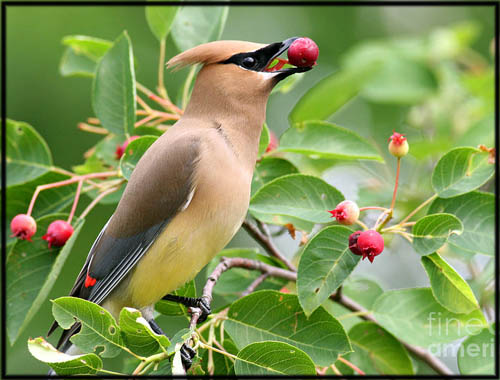So what are serviceberries?
Like the waxwing pictured, I almost don’t want to tell you, because then there might not be as many left to pick in Harriman State Park, especially as foraging is currently the hotbutton in the foodie spotlight. And especially as those woods are full of greedy migrators. But I will.
Shadberry — named because it came to fruit when the New England shad were running — is a tree that bears a sweet, round, purple little berry that hangs in clusters under round, light green leaves. They can be found in Harriman State Park, but they often grow alone — not in orchards or groups.
You’ll know serviceberries are ripe when they’ve turned a deep purple color. The tree will have berries of different stages of ripeness. Leave the light red ones alone, and go for the purple serviceberries.
Two days ago, while climbing to Sam’s Point Preserve’s ice caves, we stopped along a ridge, a marvelous viewpoint across the valley. We sat on a promontory with two other groups of people. As they were taking it all in, I noticed the serviceberry tree clinging to the rocky ledge. It was full of ripe, purple berries.
Perhaps because it was unfamiliar to so many, no one else had harvested the fruit. But we did. We sat on the cliff top and ate as many as we liked, leaving far more on the branches. They were delicious, as they are every year.
And that makes me wonder why the delicious, delightful serviceberry (or shadberry) never really took off as a fruit crop. It really is a sweet little berry. Something of a cross between a blueberry and a raspberry (but without the raspberry’s intense flavor), the serviceberry would be perfectly at home atop breakfast cereal, or mixed into pancakes or blueberry muffins.
It’s late June as I write this; the serviceberries are in fruit. I won’t tell you where I’ve found my tree.




I also love serviceberries! I give talks promoting the conservation of and planting of local native plants and relate the importance of our native plants to our wildlife’s survival. I love the photo of the cedar waxwing bird eating serviceberries. Do you know where you got the photo from? I would like to use it in my educational talks for non-profits, master gardeners, garden club groups, etc.
Hi Jan! Serviceberries are so amazing — it’s a wonder they’re not cultivated as a fruit crop in the US. (maybe they’d be difficult to pick because they’re so small, like the huckleberry?) I had a number of the trees growing in my yard and the first year they were so prolific. The next year, though, they developed some kind of furry growths on the fruit, so I left them alone. But the birds still loved them! Beautiful tree, in every season.
I can’t remember where the waxwing picture is from!